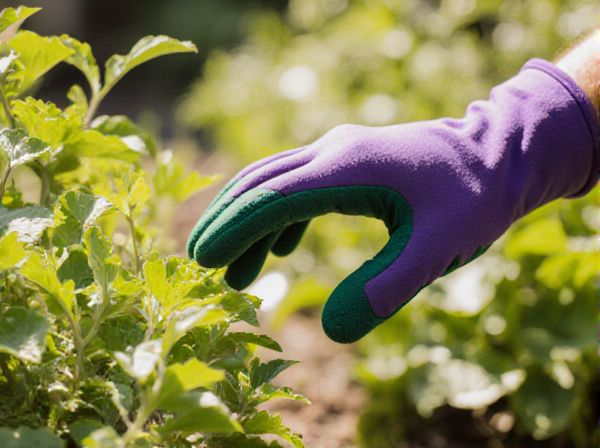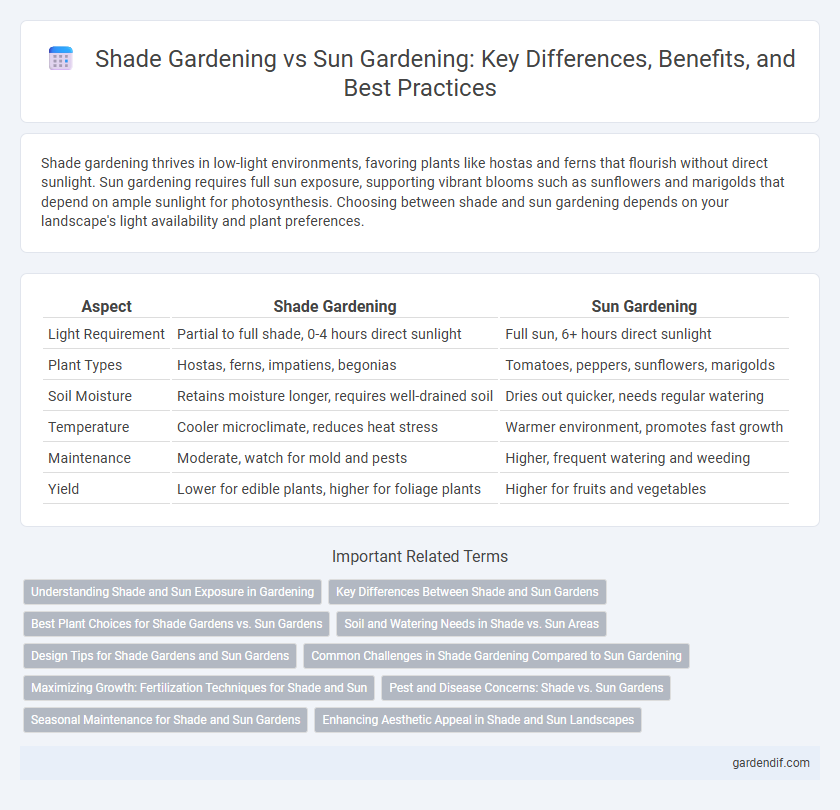
shade gardening vs sun gardening Illustration
Shade gardening thrives in low-light environments, favoring plants like hostas and ferns that flourish without direct sunlight. Sun gardening requires full sun exposure, supporting vibrant blooms such as sunflowers and marigolds that depend on ample sunlight for photosynthesis. Choosing between shade and sun gardening depends on your landscape's light availability and plant preferences.
Table of Comparison
| Aspect | Shade Gardening | Sun Gardening |
|---|---|---|
| Light Requirement | Partial to full shade, 0-4 hours direct sunlight | Full sun, 6+ hours direct sunlight |
| Plant Types | Hostas, ferns, impatiens, begonias | Tomatoes, peppers, sunflowers, marigolds |
| Soil Moisture | Retains moisture longer, requires well-drained soil | Dries out quicker, needs regular watering |
| Temperature | Cooler microclimate, reduces heat stress | Warmer environment, promotes fast growth |
| Maintenance | Moderate, watch for mold and pests | Higher, frequent watering and weeding |
| Yield | Lower for edible plants, higher for foliage plants | Higher for fruits and vegetables |
Understanding Shade and Sun Exposure in Gardening
Shade gardening thrives with plants adapted to low light conditions such as hostas, ferns, and impatiens, which require less direct sunlight and cooler environments. Sun gardening emphasizes full sun-loving species like tomatoes, lavender, and sunflowers, needing at least six hours of direct sunlight daily for optimal growth. Understanding the specific light requirements, including full shade, partial shade, and full sun, is essential for selecting appropriate plant varieties and ensuring successful garden development.
Key Differences Between Shade and Sun Gardens
Shade gardening thrives in low-light environments with plants adapted to filtered sunlight or dappled shade, emphasizing moisture retention and cooler soil conditions. Sun gardening requires full sun exposure, promoting heat-tolerant species that thrive in direct sunlight and necessitate more frequent watering. Key differences include light intensity, plant selection, soil moisture management, and temperature regulation.
Best Plant Choices for Shade Gardens vs. Sun Gardens
Hostas, ferns, and astilbes thrive in shade gardens due to their ability to flourish with minimal sunlight, whereas sun gardens benefit from sun-loving plants like lavender, sunflowers, and tomatoes that require full sun exposure. Shade-adapted plants often have larger leaves to capture limited light efficiently, while sun garden plants possess thicker, sun-tolerant foliage to withstand intense sunlight. Selecting plants based on light requirements ensures optimal growth, health, and aesthetic appeal in both shade and sun gardening environments.
Soil and Watering Needs in Shade vs. Sun Areas
Shade gardening requires soil with higher organic matter content to retain moisture effectively, as shaded areas often have cooler, damper conditions compared to sun-exposed gardens. Plants in shade typically need less frequent watering since evaporation rates are lower, whereas sun gardens demand more consistent irrigation to compensate for faster soil drying. Selecting drought-tolerant species for sunny spots and moisture-loving plants for shaded zones optimizes water efficiency and plant health.
Design Tips for Shade Gardens and Sun Gardens
Shade gardening thrives with plants like hostas, ferns, and hydrangeas that adapt well to low-light conditions, while sun gardens benefit from sun-loving plants such as lavender, roses, and marigolds. Design tips for shade gardens include using varying leaf textures and heights to create visual interest and incorporating reflective surfaces to brighten dark areas. For sun gardens, prioritize drought-tolerant species, implement layered plantings to provide depth, and consider mulching to retain soil moisture under intense sunlight.
Common Challenges in Shade Gardening Compared to Sun Gardening
Shade gardening faces common challenges such as limited photosynthesis due to reduced sunlight, resulting in slower plant growth and fewer blooms compared to sun gardening. Soil moisture retention is higher in shaded areas, increasing risks of fungal diseases and root rot, requiring careful drainage management. Shade gardens often struggle with selecting shade-tolerant plants that thrive under low light, unlike sun gardens benefiting from a wider variety of heat- and light-loving species.
Maximizing Growth: Fertilization Techniques for Shade and Sun
Maximizing plant growth in shade gardening requires selecting fertilizers rich in nitrogen to promote leafy development, as lower light limits photosynthesis. Sun gardening benefits from balanced NPK (nitrogen, phosphorus, potassium) fertilizers that support root strength and flowering under intense sunlight. Tailoring fertilization by assessing light conditions and soil nutrients ensures optimal nutrient uptake and robust plant growth in both shade and sun environments.
Pest and Disease Concerns: Shade vs. Sun Gardens
Shade gardens typically face fewer pest issues due to cooler, moister conditions that inhibit many insect populations, but may be more prone to fungal diseases like powdery mildew and root rot. Sun gardens often encounter higher pest pressure from aphids, spider mites, and caterpillars that thrive in warm, dry environments, while benefiting from faster evaporation which reduces fungal outbreaks. Effective pest and disease management strategies must consider the microclimate differences between shade and sun gardens to optimize plant health and productivity.
Seasonal Maintenance for Shade and Sun Gardens
Seasonal maintenance for shade gardens involves regular pruning of shade-tolerant plants like hostas and ferns to remove dead foliage and promote healthy growth during spring and fall. In sun gardens, maintenance requires more frequent watering and deadheading sun-loving blooms such as marigolds and petunias to manage heat stress and prolong flowering. Both garden types benefit from soil amendment with organic mulch in early spring to retain moisture in sun gardens and improve nutrient availability under low-light conditions in shade gardens.
Enhancing Aesthetic Appeal in Shade and Sun Landscapes
Shade gardening offers a unique opportunity to enhance aesthetic appeal by incorporating shade-tolerant plants such as hostas, ferns, and astilbes that provide lush textures and rich green hues. Sun gardening, in contrast, emphasizes vibrant blooms like petunias, marigolds, and sunflowers that add bright colors and dynamic visual interest to landscapes. Combining elements of both shade and sun gardens allows for a balanced, visually stimulating environment that maximizes plant diversity and seasonal variety.
shade gardening vs sun gardening Infographic

 gardendif.com
gardendif.com